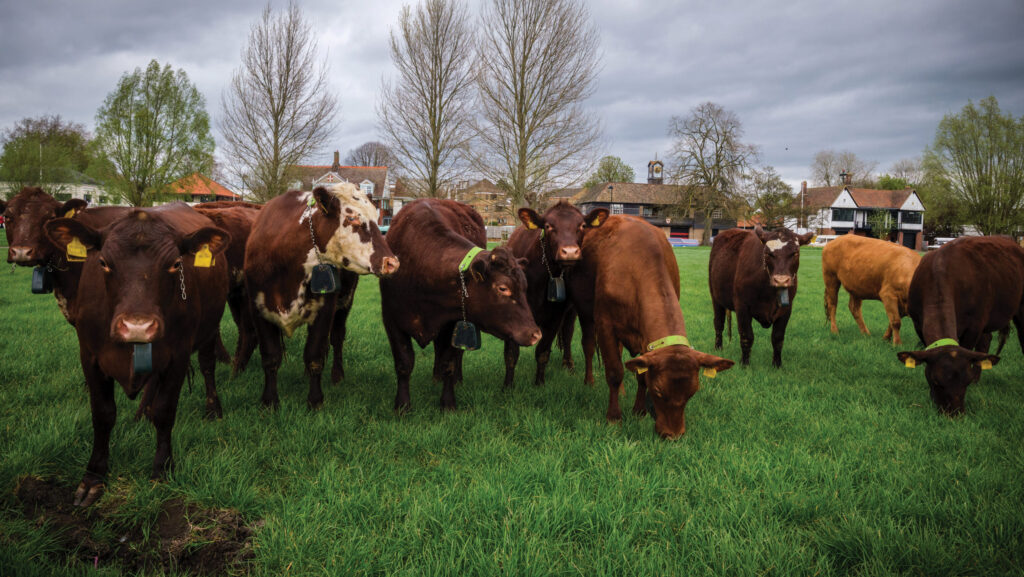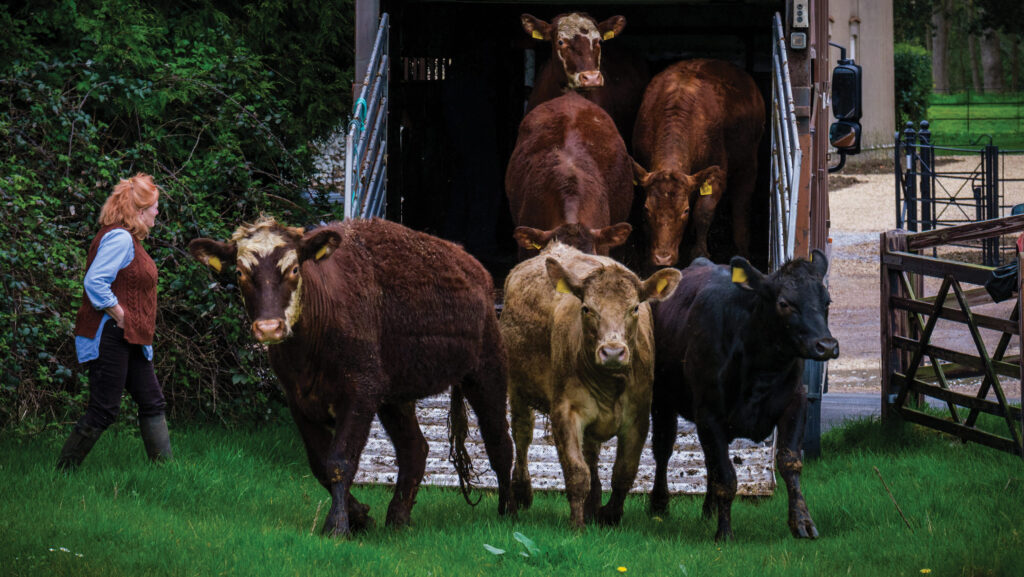Conservation grazing grows as alternative land uses develop
 Midsummer Common © Jason Bye
Midsummer Common © Jason Bye Biodiversity net gain (BNG) became mandatory in the planning system in England from February 2024, allowing landowners to earn an income from selling biodiversity units to developers.
This is just one alternative land use which is covering a growing number of acres, alongside private conservation and nature restoration projects, as well as nutrient mitigation measures.
In some regions the BNG market has exposed an important gap – a shortage of livestock to manage this new habitat land.
See also: Biodiversity net gain is a slowly developing market
Conservation grazing market – key points
- Growing need for grazing on a range of conservation and nature restoration land to achieve desired habitats
- Shortage of graziers in some areas, particularly south-east England
- Breeds must be carefully selected
- Flexibility needed to manipulate stocking rates
- Large range of rents, including some ground at no charge
- Potential for graziers to be paid to graze stock in some cases
- Wide range of agreements and terms depending on conservation/restoration/habitat creation aims
- Biodiversity net gain is a legal requirement to the promised uplift in biodiversity must be achieved.
Opportunities for livestock
Livestock are an important tool for managing conservation land through grazing, and in the case of BNG, helping to deliver the required minimum 10% biodiversity uplift.
However, the parts of the country where residential, industrial and commercial development is most active, such as the South East, have the fewest cattle and sheep.
This could present an opportunity to diversify farming and for some, to begin a grazing enterprise.
Although the market is in its infancy, a need to have graziers on this land is already apparent, says Lisa Bulmer, an associate in the natural capital team at Bidwells, who is involved in developing BNG schemes.
“Development pressure is driving an increase in habitat banks which often require graziers, and there are parts of England with greater pressure that won’t be reducing any time soon.
“Getting more graziers established and closing the gap that currently exists should be a priority.’’
Grazing creates the sward height and diversity needed for the higher habitat conditions stipulated by the biodiversity metric, with rooting and trampling adding to the diversity of insects and wildlife.
“If landowners are going to target those higher distinctiveness grasslands and deliver the highest ecological outcomes, they have to go down the grazing route, mowing alone won’t get them there,’’ says Lisa.
The stock types need to be right for the ground and conditions. It is also important to have the flexibility to manipulate stocking rates. This is often trickier for smaller landowners with BNG land, Lisa suggests.
“Larger estates which have excess land can move livestock around to provide that control, but it’s not so easy for smaller landowners who need conservation grazing for a period of the year and then need those livestock to go elsewhere.
“The ability to have livestock on the site for a limited or extended period of time and for the grazier to be in a position to move them off as and when needed is really important.’’

© Jason Bye
Payment
This offers an opportunity for bespoke grazing agreements, which specify the outputs required on land, where grazing needs to be targeted and adapted to how vegetation is developing and establishing.
Typical rents which graziers might expect to pay for grazing large-scale BNG land are lower than for conventional grazing because the land offers lower quality grazing and lower stocking rates.
For sites that offer fewer benefits to graziers, such as a requirement for a very low stocking density, a rent is unlikely to be charged, says Lisa. There could even be some form of payment to the grazier.
Lisa, cites an example of BNG where the landowner income is substantial, so payments to graziers can be accommodated.
“Where access to livestock is very hard to come by and very necessary for the outcome of a scheme, there is probably an expectation that a grazier would be paid for providing a service,’’ she says.
“Where there is more competition for grazing and the livestock keeper will get more benefit out of the arrangement, for example producing beef for a premium market and where they get most of their income from that, they might be expected to pay a rent, but at a reduced rate due to the need to be flexible with the grazing regime, and to have the resources to remove livestock from the site when required.’’
Where some BNG and other conservation land is not grazed, it would need to be mechanically cut and the grass collected, a cost consideration when setting rents or payments.
Although that grass might initially have a value as hay, leys become less productive as a scheme progresses, so conserved forage is likely to have little feed value.
“The grass still needs to be cut and collected though, which is a direct cost to the landowner.
“Therefore this should be taken into account when setting a rent as the grazier will remove the requirement for this cost to be incurred,’’ says Lisa.
Conservation grazing agreements
The type of agreement used and its terms will depend on the scheme, and what the grazier can offer.
If, in addition to grazing, they may also provide hedgerow or tree maintenance for example, a longer-term agreement through a farm business tenancy (FBT) with strict management prescriptions and biodiversity net gain (BNG) outputs stipulated might be appropriate, says Lisa.
Alternatively, it could be a shorter-term agreement, perhaps a one year arrangement, where the grazier is contracted to only provide certain services and to graze for specific periods of the year.
“The type of agreement is very dependent on the grazier and what resources and skills they have, and how local they are too in terms of managing the stock,’’ says Lisa.
While the landowner will usually be expected to provide fencing, some graziers may run cattle with “no-fence” GPS collars.
Water supply and associated infrastructure are essential, and handling facilities may be required. In some cases landowners may offer buildings for overwintering.
Conservation grazing might be more of a challenge for those who don’t have access to other land as the prescriptions for the BNG site can change, such as if there has been a lot of poaching after a sustained period of rain and animals need to be removed.
“If they are asked to take livestock off early, both parties need to have the confidence that they have an alternative place for them to go,’’ says Lisa.
“Likewise, if the landowner wants to extend the grazing they need to know they are going to have flexibility in the contract to keep the animals on the land for longer.’’
Specific breeds
For graziers who are considering entering this market, livestock breeds are an important consideration.
Native breeds are well suited to grazing land in BNG and other environmental schemes.
These are often hardy, more able to be outdoors for longer periods, potentially over wintering in the fields which can be beneficial to some schemes.
But it is not only livestock type that is important, but the ambitions of the grazier too.
“When cattle are left out for these longer periods of time on poorer grazing they are not going to make the same level of return as a more efficient animal in a conventional farming situation,” says Lisa.
“So this market is better suited to individuals who genuinely have an interest in sustainably managing land for the long term.”
While established farmers are likely to be interested in these agreements, Lisa also sees this as a potential route for a new entrant.
“For someone who doesn’t have a family history of farming but is absolutely eager to get into that space and develop a career in the industry, schemes like this might offer them that opportunity.’’

© Bidwells
Case study: Midsummer Common
Angelika von Heimendahl pays £48/cow/year to graze Red Poll cattle on Midsummer Common and on meadows in and around Cambridge, on land owned by Cambridgeshire City Council.
Although she also has access to conservation grazing on other land, the fee in this specific agreement is largely a contribution towards the cost of a city employee to manage her cows and those of the other graziers.
She has access to some other land for no charge and pays a low rent on further ground in the Cambridge area, with a stocking rate of about two head a hectare.
For Angelika, whose family is not involved in agriculture, conservation grazing opportunities like this one offer a route into beef production.
“I didn’t have a farm or any land, so grazing commons and nature reserves were the only opportunity to start a livestock business,’’ she says.
Angelika, who is also a vet, winters her herd on an arable holding just outside Cambridge on a bed and breakfast agreement.
Her 60 Red Polls are a good match for conservation grazing because they are non-selective grazers, docile and, at 500-550kg mature weight, smaller than some other breeds.
They are bought in as stores and finished at about 28 months.
Angelika’s income from the herd comes from selling the meat at Cambridge Local Produce Market and to two butchers in Cambridge. The venture is profitable but not hugely so, she says.
More recently her cattle grazing in Cambridge have been fitted with GPS collars, paid for by the council.
Angelika works with other graziers to provide a conservation grazing service for landowners.
“Ruminants have their place in nature, in conservation, and in farming,” she says. “Cattle are ideal to keep areas open and allow flora and fauna depending on grassland to thrive.
“They are more effective than machines and are easier to organise than many hours of volunteers.’’
